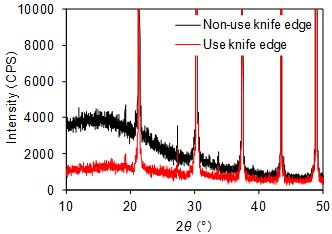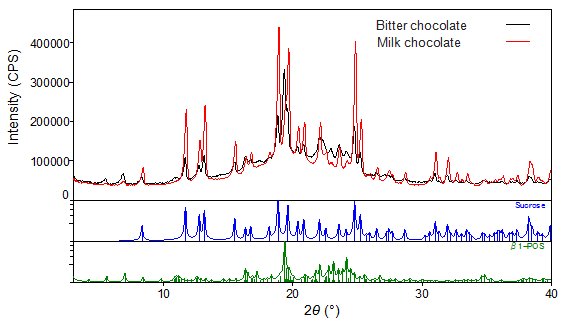The MiniFlex300/600 can be equipped with the D/teX Ultra high-speed 1-dimensional detector to obtain greater intensity. This detector has a broad detection surface and can efficiently count diffraction X-rays from a sample. As a result, it is possible to obtain intensities from a few tens to roughly 100 times greater than a scintillation counter. Background can also be reduced using the fluorescent X-ray reduction mode, or knife edge etc. Fig. 1 shows the X-ray diffraction patterns obtained when a knife edge is installed versus no knife edge. By using a knife edge, it is possible to achieve an extreme reduction in scattering on the low-angle side. Also, the knife edge moves in a way which is dependent on the diffraction angle 2θ, and thus there is no blind spot (intensity attenuation) on the high-angle side, and measurement can be done from the low-angle side to the high-angle side.

Fig. 2 shows the X-ray diffraction patterns for milk chocolate and bitter chocolate, measured using a knife edge. The background on the low-angle side is suppressed to a low level, and it is evident that the diffraction peaks on the low-angle side of the cacao butter (POS: a structure combining palmitic acid, oleic acid and stearic acid) contained in the chocolate are clearly observed. Without using a knife edge it would have been harder to observe the low angle peaks, especially for the minor component.

Apparatus condition:
MiniFlex600 (F.F tube 40 kV, 15mA), Detector: D/teX Ultra, Slit conditions: DS = 0.625°, SS = 8 mm, RS = 13mm, Incident side and receiving side Soller slit: 5°, Incident height limiting slit = 10 mm
Measurement condition:
Scan range: 2θ = 3 ~ 40°, Step width: 0.02°, Scan speed: 20° / min. (about 2 min.)
